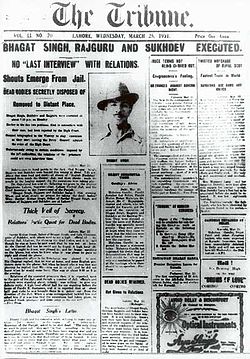Shivaram Rajguru
Shivaram Hari Rajguru | |
|---|---|
 Rajguru | |
| Born | 24 August 1908 |
| Died | 23 March 1931 (aged 22) |
| Occupation | Indian freedom fighter |
| Organization | HSRA |
| Movement | Indian Independence movement |
Shivaram Hari Rajguru (24 August 1908 — 23 March 1931)[1][2] was an Indian revolutionary from Maharashtra, known mainly for his involvement in the assassination of a British police officer named John Saunders. He was an active member of the Hindustan Socialist Republican Association (HSRA) and on 23 March 1931 he was hanged by the British government along with his associates Bhagat Singh and Sukhdev Thapar.
Early life[edit | edit source]
Rajguru was born on 24 August 1908 at Khed to Parvati Devi and Harinarain Rajguru in a Marathi Deshastha Brahmin family. Khed was located at the bank of river Bheema near Pune. His father died when he was only six years old and the responsibility of family fell on his elder brother Dinkar. He received primary education at Khed and later studied in New English High School in Pune. He joined Seva Dal at a young age. He attended training camp conducted by Dr. N. S. Hardikar at Ghatprabha[1]
Revolutionary activities[edit | edit source]
He was a member of the Hindustan Socialist Republican Association, who wanted India to be free from British rule by any means necessary.[2]
Rajguru became a colleague of Bhagat Singh and Sukhdev, and took part in the assassination of a British police officer, John Saunders, at Lahore on 17 December 1928. Their actions were to avenge the death of Lala Lajpat Rai who had died a fortnight after being hit by police while on a march protesting the Simon Commission.[2] Rai's death resulted from the police action.[3][4]
The three men and 21 other co-conspirators were tried under the provisions of a regulation that was introduced in 1929 specifically for that purpose.[5] All three were convicted of the charges.
Executions[edit | edit source]

Scheduled for hanging on 24 March, three freedom fighters were hanged a day earlier on 23 March 1931. They were cremated at Hussainiwala at the banks of the Sutlej river in the Ferozepur district of Punjab.[6][1]
Reactions to the executions[edit | edit source]
The executions were reported widely by the press, especially as they took place on the eve of the annual convention of the Congress party at Karachi.[7] The New York Times reported:
A reign of terror in the city of Cawnpore in the United Provinces and an attack on Mahatma Gandhi by a youth outside Karachi were among the answers of the Indian extremists today to the hanging of Bhagat Singh and two fellow-assassins.[8]
Legacy and memorials[edit | edit source]
National Martyrs Memorial[edit | edit source]
National Memorial is located at Hussainiwala, in Ferozepur district of Punjab in India. After the execution in Lahore jail, the bodies of Shivaram Rajguru, Bhagat Singh, and Sukhdev Thapar were brought here in secrecy and they were unceremonially cremated here by authorities. Every year on 23 March, martyrs day (Shaheed Diwas) is observed remembering three revolutionaries. Tributes and homage are paid at the memorial.[9][6]
Rajgurunagar[edit | edit source]
His birthplace of Khed was renamed as Rajgurunagar in his honour.[2] Rajgurunagar is a census town in Khed tehsil of Pune district in state of Maharashtra.[10]
Rajguru Wada[edit | edit source]
Rajguru Wada is the ancestral house where Rajguru was born. Spread over 2,788 sq m of land, it is located on the banks of Bhima river on Pune-Nashik Road. It is being maintained as a memorial to Shivaram Rajguru. A local organisation, the Hutatma Rajguru Smarak Samiti (HRSS), hoists the national flag here on Republic Day since 2004.[11]
College[edit | edit source]
Shaheed Rajguru College of Applied Sciences for Women is located in Vasundhara Enclave, Delhi, and is a constituent college of Delhi University.[12]
See also[edit | edit source]
References[edit | edit source]
- ↑ 1.0 1.1 1.2 Verma, Anil (15 September 2017). RAJGURU – THE INVINCIBLE REVOLUTIONARY. Publications Division Ministry of Information & Broadcasting. ISBN 978-81-230-2522-3.
- ↑ 2.0 2.1 2.2 2.3 "Remembering Shivaram Hari Rajguru on his birthday". India Today. 24 August 2015. Retrieved 28 May 2018.
- ↑ Sawhney, Simona (2012). "Bhagat Singh: A Politics of Death and Hope". In Malhotra, Anshu; Mir, Farina (eds.). Punjab Reconsidered: History, Culture, and Practice. Oxford University Press. p. 380. doi:10.1093/acprof:oso/9780198078012.003.0054. ISBN 978-0-19807-801-2.
- ↑ Nair, Neeti (May 2009). "Bhagat Singh as 'Satyagrahi': The Limits to Non-violence in Late Colonial India". Modern Asian Studies. Cambridge University Press. 43 (3): 649–681. doi:10.1017/s0026749x08003491. JSTOR 20488099. S2CID 143725577.
- ↑ Dam, Shubhankar (2013). Presidential Legislation in India: The Law and Practice of Ordinances. Cambridge University Press. p. 44. ISBN 978-1-10772-953-7.
- ↑ 6.0 6.1 "National Martyrs Memorial Hussainiwala". Firozepur district official website. Retrieved 27 May 2018.
- ↑ "Bhagat "Indian executions stun the Congress". The New York Times. 25 March 1931. Retrieved 11 October 2011.
- ↑ "Bhagat "50 die in India riot; Gandhi assaulted as party gathers". The New York Times. 26 March 1931. Retrieved 2011-10-11.
- ↑ "Five decades on, heritage status eludes Hussainiwala memorial". The Tribune India. 27 September 2017. Retrieved 28 May 2018.
- ↑ "Rajgurunagar Population Census 2011". 2011 Census of India. Retrieved 28 May 2018.
- ↑ "Freedom fighter Rajguru's wada". DNA India. 21 September 2013. Retrieved 27 May 2018.
- ↑ "Shaheed Rajguru College of Applied Sciences for Women". Official website of college. Retrieved 28 May 2018.
Further reading[edit | edit source]
- Noorani, Abdul Gafoor Abdul Majeed (2001) [1996]. The Trial of Bhagat Singh: Politics of Justice. Oxford University Press. ISBN 0195796675.
- 1908 births
- 1931 deaths
- Revolutionary movement for Indian independence
- Executed revolutionaries
- Indian revolutionaries
- Brahmin Indian independence activists
- 20th-century executions by British India
- Executed Indian people
- People executed by British India by hanging
- People executed for murdering police officers
- Hindustan Socialist Republican Association

